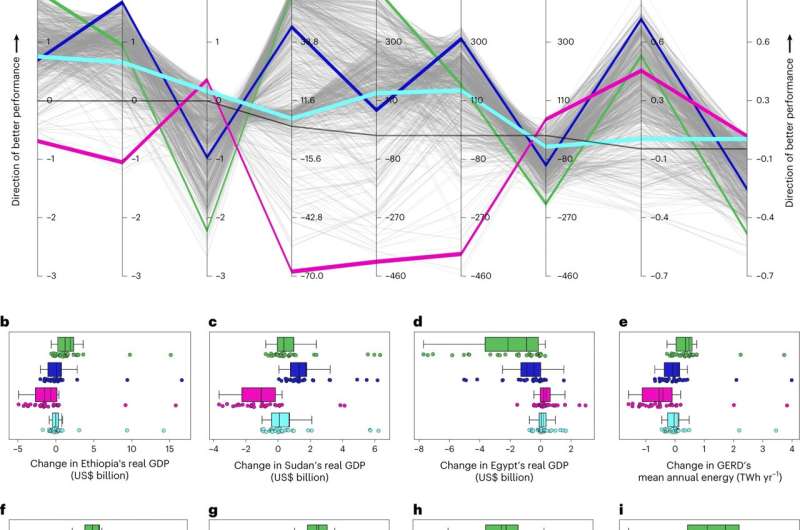Trade-offs and synergies between Ethiopian, Sudanese and Egyptian economy-wide and river system performance objectives. a, Parallel coordinates plot of the performance under efficient designs of an adaptive GERD management policy across 29 climate change projections for 2020–2045. b–i, Box plots of some of the metrics shown in a for selected designs across the 29 climate change projections. All change values are calculated from a baseline in which the GERD is operated on the basis of the Washington draft proposal. The box plots in b–i correspond to the lines with similar colors in a. The ends of the boxes in b–i represent the upper and lower quartiles, the solid vertical lines inside the boxes mark the medians, the dashed vertical lines mark the means, the circles show the data points and the whiskers extend to the maximum and minimum values, excluding the outliers. The firm power values are calculated on the basis of a 90% reliability, and the GDP values are discounted at a 3% rate. Credit: Nature Climate Change (2023). DOI: 10.1038/s41558-022-01556-6
New research led by The University of Manchester has developed unique river basin modeling software which, for the first time, combines reservoir management, economy-wide performance, and artificial intelligence techniques to design adaptive plans for various climate change situations.
Published in Nature Climate Change, it reveals solutions that can provide greater economic benefits for the nations affected by the construction of the Grand Ethiopian Renaissance Dam (GERD)—Ethiopia, Sudan and Egypt—when compared with a negotiated proposal.
The dam has triggered political tensions between the three countries, with negotiations yet to reach an agreement on how to fill the reservoir and on its operation during periods of drought.
Uncertainty exists about the impact of future climate change on the Nile's economies and water-dependent sectors—this further complicates the frictions over the GERD, which have been ongoing since 2011 and remain unresolved as work on the dam nears completion.
Negotiations have not thus far considered the impact of climate change on the dam, and proposals for its management often result in economic gains for one country being prioritized to the detriment of the others.
The implications of climate change uncertainty for the Nile's hydrology (for example, streamflow and irrigation demands) and the economies of the countries it flows through (for example, future economic development trajectory, population growth and climate policies) mean non-adaptive dam management could perform poorly especially when rules are designed based on current and past conditions.
Adaptive management plans involve short-term actions and adaptation mechanisms as climate change unfolds, and using such plans to manage the Nile's infrastructure helps it to better cope with climate change uncertainty. Designing management strategies for large dams in such ways benefits from a multi-dimensional approach to encourage collaboration, identify efficient trade-offs and optimize economic performance.
This new study, which uses unique joint river-system and economy modeling simulators coupled with artificial intelligence techniques, enables the estimation of economic and engineering performance metrics under various management plans and climate change projections. It reveals how several compromises exist which can improve performance for all three countries compared to the latest published proposal.
"Nile negotiations have aimed to produce static long-term agreements, but there is high uncertainty on the medium and long-term impacts of climate change on the basin's rainfall, streamflow, temperature, and socio-economic systems—this paper proposes an analytical approach that can help design adaptive agreements given these uncertainties," says Dr. Mohammed Basheer, lead author of the paper.
More information: Julien Harou, Cooperative adaptive management of the Nile River with climate and socio-economic uncertainties, Nature Climate Change (2023). DOI: 10.1038/s41558-022-01556-6. www.nature.com/articles/s41558-022-01556-6
Journal information: Nature Climate Change
Provided by University of Manchester























